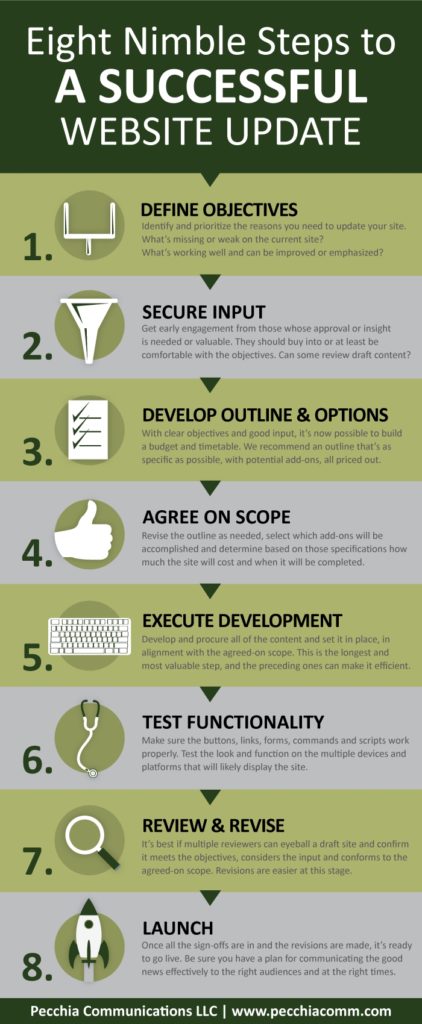20
2017

For a downloadable PDF of the graphic, click here.
By Kelli Johnston
Email, text, chat and other forms of digital communication have become so efficient in saving time and money that the benefits of traditional, in-person collaboration are often overlooked.
But for complex projects, face-to-face communication can actually improve efficiency. Nowhere is this more important than in website development, where inadequate communication can easily throw a project off course and over budget.
Here are two pitfalls that frequently challenge website projects — all of them have to do with ineffective communication — and two common-sense strategies to avoid them.
Pitfall 1: Loosely Defined Scope
Website projects tend to have multiple stakeholders, often from different parts of an organization, and/or with different viewpoints, so their interests may not align. For example, some may be looking for a mind-blowing design, others might be laser-focused on branding and still others might be concerned that “my information” is included prominently.
Satisfying potentially conflicting interests is even more challenging when the development team and those responsible for it are under orders to spend as little as possible.
The best way to solidify agreement on the scope is to spell it out in writing and ask everyone involved to contribute to it and sign off on it. Once approved, this document can provide perspective to any input about the site.
A scope document should include, among other things, what the site’s objectives are, what content will be included and who will develop or procure it. It should also cover conclusions about design and specify if relevant what will not be included.
Pitfall 2: Overlooked Details
Almost all stages of website development include details that can be missed. Scope outlines, sample layouts, longer sections of text and the draft site itself offer the greatest opportunities to confuse oversight with approval.
These stages can require hundreds of decisions on issues ranging from the colors and shapes of buttons to the accuracy of critical information.
Participating in a website project is time-consuming and requires careful consideration to all of the details involved. Time needs to be figured in for thorough review.
Solution 1: In-Person Meetings
In the context of a website project, opportunities to “walk through” long and complex documents and themes are valuable. Specifics can be pointed out or dwelled on during a walk-through, and the speaker can tell if the listener is digesting the information, has questions or outright disagrees.
It’s easier in a meeting to tell if someone is engaged, then take the opportunity to ask, “Is this OK?” Moreover, when an in-person meeting is scheduled, it’s more likely that the person responsible for bringing something that is due (or overdue) is going to make good.
This is a far cry from emailing links to layout options or website drafts and hoping they’ll be studiously read.
It’s important to note that in-person meetings take time, and time has to be covered in development budgets and in the time schedules of those who wish to be involved.
Solution 2: Logical & Reliable Process
Another way to discourage communication pitfalls is to follow a logical process. For example, the time to define objectives isn’t right before the site goes live. And there’s no sense investing time in reviews before the content is fully in place.
We recommend setting objectives first (see infographic), then collecting the right input before developing a content outline and layout options.
Getting feedback on the outline and proposed designs — before development time is invested — conserves time and expense. Based on this feedback, a scope can be developed and worked through to approval. Then the development can begin.
As is the case with meetings, these pre-development steps take time and need to be factored into budgets and schedules.
Any organization considering a new website or a major update has two major concerns – time and money — and rightly so.
A reliable process, supported by in-person meetings at key points, can alleviate both of those concerns and support a successful website project.
Kelli Johnston is a public relations consultant and project manager with Pecchia Communications.
Latest Posts
- 3 Media Relations Guidelines for an Era of Growing Distrust May 5, 2025
- Brighten Up Your Brand: 3 Tips for a Summer Messaging Makeover May 5, 2025
- Pecchia Comm Lands 18th Major Change Engagement May 5, 2025
- Student Journalism Awards Lead Press Club’s Plans for 2025 March 6, 2025
- Pecchia Comm Plans $20K Grant to Celebrate 20th Anniversary February 26, 2025
- Power of Print Still Endures in Employee Comms February 5, 2025
- 6 Essential Communications Strategies for Managing Organizational Change February 4, 2025
- Factory Work Instructions Drive Compliance, Consistency February 3, 2025
6725 Pheasant Run Drive | Youngstown, Ohio 44406 | Privacy Policy

